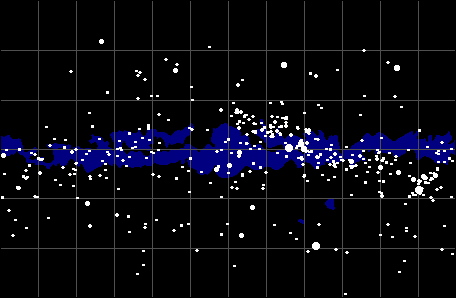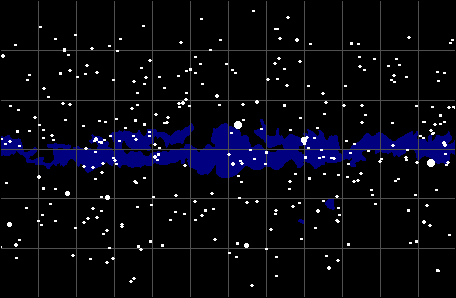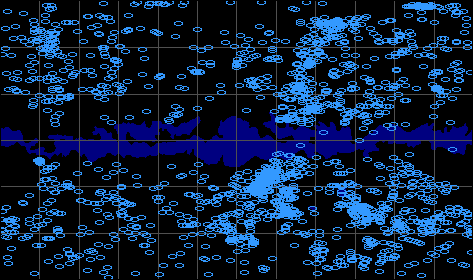

Notice the two small clouds below the plane of the Milky Way. Those are the Large and Small Magellanic Clouds (LMC and SMC), two small companion galaxies to our own that are visible generally only in the Southern Hemisphere on Earth. Compare that map to the map below of the M stars (the cool, red population of stars).

On your worksheet, state which type of stars (O/B or M) are more concentrated toward the disk of the Milky Way galaxy.
Now let's apply some of what we've learned so far in class to this problem. First of all, based on what you've learned so far in the lecture part of the class, which of the two distributions of stars is probably younger? Answer this question and provide an explanation on your worksheet.
It turns out that most stars form in the disk of the Milky Way galaxy (that's where most of the gas and dust is, after all), but given enough time, random interactions between stars and the rest of the mass in the disk will result in some stars being kicked out of the plane of the galaxy. Over time, stars diffuse away from the plane of the Milky Way galaxy much like dye diffuses through a liquid. That's why the older stars tend to be less concentrated toward the disk of our galaxy than younger stars. The younger stars simply haven't had time to diffuse outward.
As a final exercise, look at the image below, which maps the distribution of other visible galaxies in the sky. These are the galaxies we can see (usually with powerful telescopes) from Earth. Notice how, unlike stars, galaxies tend to appear only OUTSIDE the disk of the Milky Way. Can you explain this, based on what you've learned in lecture?

Step 4 - Essay
I'm going to ask you now to read an article about the continuing formation and evolution of the Milky Way galaxy, entitled "Our Growing, Breathing Galaxy". To access the article, please do the following steps:
Answer the following questions from the article, and these answers will constitute your essay:
(1) What are HVC's, and where do they come from?
(2) How might HVC's help explain the fact that in the solar neighborhood, stellar ages and metallicities don't really seem to have much of a correlation, contrary to what Astronomers have expected.
(3) What is the likely origin of HVC complex C, and what evidence supports this idea? What is a "galactic fountain"? How do we know that HVC's are not part of a galactic fountain process? Explain.
(4) What are IVC's? What evidence supports the idea that IVC's are part of a galactic fountain process?